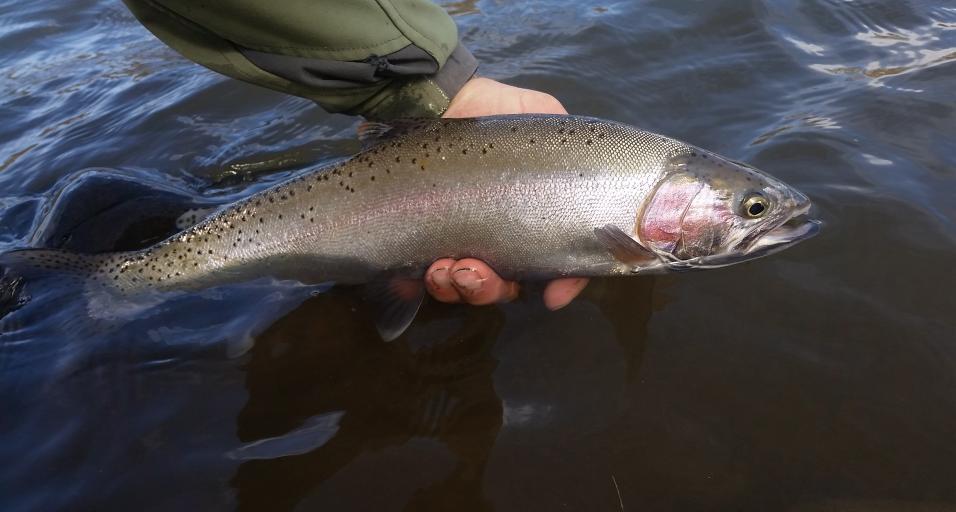Buffalo Bill Reservoir, located approximately 10 miles west of Cody, is one of the most unique and important standing water fisheries in the Bighorn Basin. Unlike other reservoirs in Wyoming, Buffalo Bill is not stocked with hatchery fish. “The fact that Buffalo Bill Reservoir is not stocked is extraordinary,” said Cody Region Fisheries Biologist Jason Burckhardt. “In fact, it is the only self-sustaining, wild trout reservoir that exists in Wyoming.”
But there is much more to the story than just a quality wild trout reservoir fishery. Each spring, adult rainbow trout, Yellowstone cutthroat trout and their hybrids (cutbows) run up the North Fork Shoshone River and tributaries to spawn. This spawning run is well known to anglers near and far; thousands of anglers descend on the North Fork and it’s tributaries each summer to fish for the migratory trout.
With the illegal introduction of walleye in the reservoir in the early 2000’s, this trout fishery and the unique angling opportunities it offers are threatened. Efforts are currently underway to ensure the sustainability of this incredible trout fishery for future generations.
During the summer of 2008, anglers began catching walleye in Buffalo Bill Reservoir and Game and Fish confirmed that walleye had been illegally introduced. “Walleye and trout living together in a reservoir, more often than not, leads to a decline in the trout population,” Burckhardt said. “In these situations trout are often the primary forage base for walleye and as the walleye population expands, the trout population declines. In the end, managing for a quality fishery for either species is difficult.” Given the popularity with anglers and the uniqueness of this trout fishery, Game and Fish is remiss to let the situation play out unchecked. “We wanted to approach this situation in a thoughtful and coordinated fashion,” Burckhardt said. “So we came up with a game plan based on experiences of other professional fish managers grappling with similar challenges.”
Game and Fish had to answer two looming questions in order to determine how the illegal introduction of walleye could influence the trout population. The first was a food web study to determine lake trout and walleye consumption rates on trout. “This food web study was essentially a ‘who’s eating whom’ investigation where we determined the diets of all predatory fish in the reservoir,” Burckhardt said.
“What we found was that trout, specifically juvenile trout, comprise a majority of a walleye’s diet. This research confirmed what we had feared; that the introduced walleye had the potential to significantly impact the Buffalo Bill trout fishery, especially if that population continued to grow.
The second series of questions that Game and Fish had to answer was how many walleye are in Buffalo Bill, how many are being harvested by anglers, and what would it take in terms of removal efforts to keep the walleye population from expanding. Beginning in 2016, in collaboration with researchers from Montana State University, Game and Fish began investigating the feasibility of suppressing walleye in Buffalo Bill Reservoir in order to sustain the trout fishery.
To estimate abundance of walleye and angler exploitation rates, Game and Fish tagged approximately 500 walleye in the spring of 2016 with reward tags. “We determined that the Buffalo Bill Reservoir walleye population was smaller than we anticipated, with only a few thousand sexually mature fish in the entire reservoir. We also determined that anglers harvested approximately twenty percent of the tagged fish which was a bit surprising given the fairly low abundance of walleye in the Reservoir.” Burckhardt said.
“Now that we had these key pieces of information, the final question was how many walleye could we remove with the tools we have available,” Burckhardt said. In the spring of 2017, when the walleye were congregating during spawning, Game and Fish used electrofishing and gillnetting to remove as many walleye as possible to determine if it is feasible to keep the walleye population low enough to prevent it from growing to the point that it may affect the Buffalo Bill Reservoir trout fishery. Over the course of three weeks a little over 800 walleye were removed from Buffalo Bill. While the field work is completed, the analysis of the data will continue through this winter.
A brief history: Stocking Buffalo Bill Reservoir
- Buffalo Bill Reservoir was constructed in 1910 at the confluence of two major tributaries, the North and South Fork Shoshone Rivers.
- A variety of trout were stocked soon after the dam’s closure including rainbow trout, lake trout, and Yellowstone cutthroat trout.
- Rainbow trout were last stocked in 1949; lake trout in 1955.
- From 1955 through 1995, Yellowstone cutthroat trout were stocked.
- All stocking was discontinued in 1995 when it was determined that stocked fish were not substantially contributing to the fishery and that natural reproducing “wild” trout could support the fishery.
------
Story and photos by Tara Hodges, Jason Burckhardt and Sam Hochalther, Cody Region. For more Cody Regional news, visit the Cody Regional Website.
In top photo: A Buffalo Bill Reservoir cutbow

